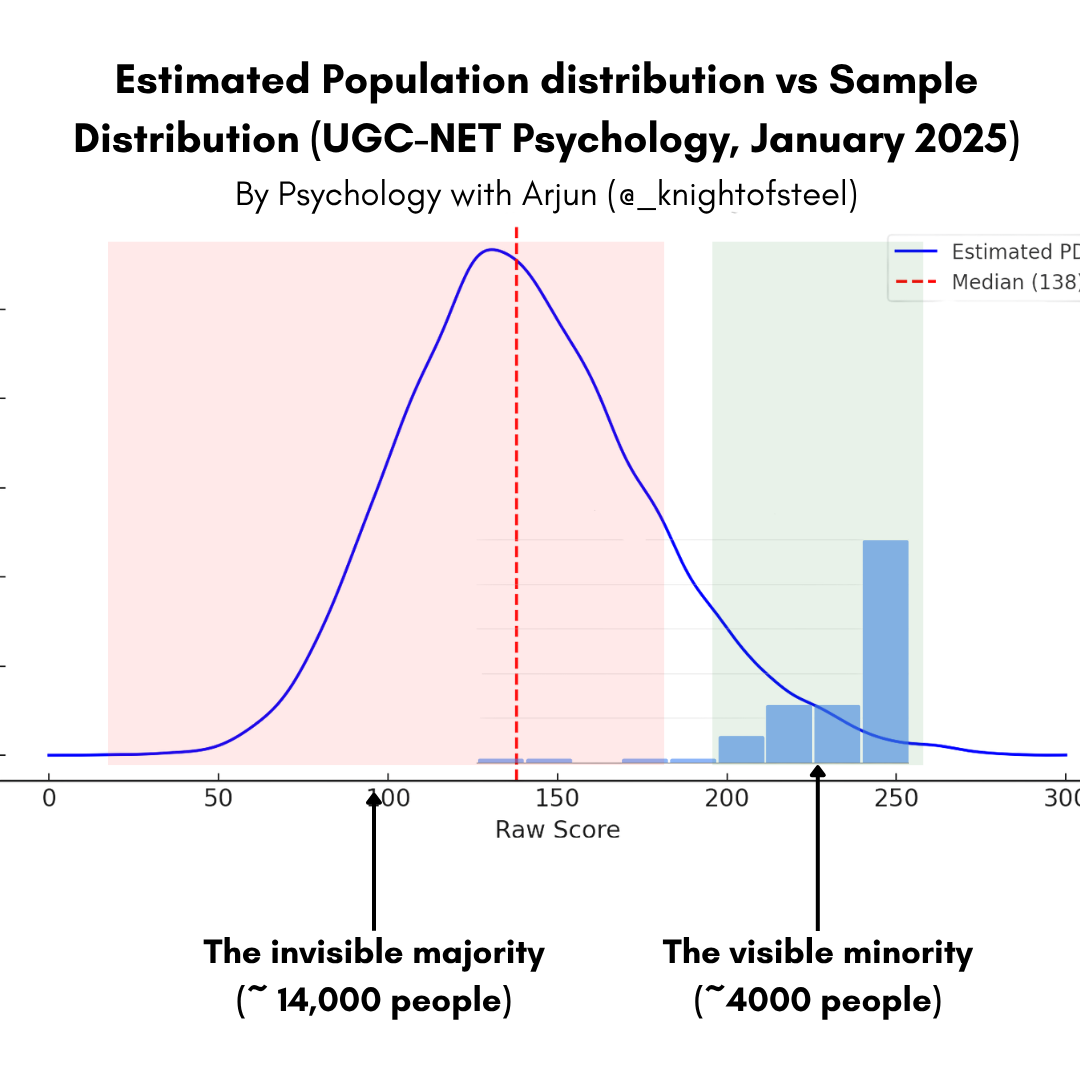Using Statistics to Investigate UGC-NET Aspirants
Who appears for the UGC-NET exam? What do we know about them from stats?
Statistics, as it is taught, can seem monotonous, scary, or worse, impossible. Unfortunately, our education system still teaches stats through manual calculations and memorizing formulas. Today, I hope I can show you a glimpse of what is possible through statistics.
After the UGC-NET results for January 2025 were announced, I collected the scores and percentiles of 90 individuals to see what we can infer about those who appear for the UGC-NET. Here’s what the data can tell us.
What is UGC-NET?
For the uninitiated, it is just another exam that qualifies you to teach in colleges. For psychology students, it is the most important exam of their lives. For me, it is the most mind-numbingly stupid exam I have had the misfortune of appearing for.
The exam is conducted twice every year, either in freezing cold weather or in scorching heat. If you make it through, you are eligible to teach in colleges, pursue a PhD, and a lucky few who receive a fellowship called the Junior Research Fellowship. Despite its quality, the exam opens up loads of opportunities for young students.
What did I do?
With the right amount of data, you can tell a lot about people who appear for an exam. The challenge, of course, is finding the right kind of data.
When you get the results for the exam, you are told
Your total score,
your percentile (how many people you outscored), and
How many people in total appeared for the exam
If you combine this data from enough people, say about 90, you can make some reasonable assertions about the distribution of scores for the whole population. (everyone who appeared for UGC-NET Psychology)
In statistics, we use data from a small sample to make some reasonable inferences about a population. I am using the same principles here.
Once the results were announced, I asked people to share their raw scores and percentiles, either publicly or privately.
Unsurprisingly, most people who responded were high scorers.
We attach shame to our scores on an exam. This means that those with low scores feel embarrassed about sharing what their scores were, even if for the sake of science.
As you can see above, most of the submitted scores belonged to the upper 10th percentile. Nearly 50% of the people who submitted their data had percentiles between 93.3-100%ile. This creates problems.
With such little data from below the 50th percentile, we need to do A LOT of estimation. Estimation means error
The online world overrepresents high scores, making them seem more common than they are.
By definition, scores with high percentiles are rare. If you scored in the 98th percentile, it means you outscored 98% of the people who appeared for the exam. That’s impressive.
However, if you are surrounded by people who score in the 99.9th percentile, you may feel like you are not that good - a result of survivorship bias. You could outscore thousands of people and still feel bad about not outscoring a few hundred.
The Silent Majority
So, who appears for UGC-NET?
More than 18,000 people appeared for this exam in January. Yet, the online world only seems to represent the top 20% of these folks.
There could be two explanations for this:
My methods of seeking out people and their scores were not enough. I used social media like Instagram and LinkedIn, whereas I might have had better results with Telegram and WhatsApp groups.
A large group of people who appear for UGC-NET simply aren’t online and are beyond our reach
Have you ever wondered who these people are? They are not online. They don’t participate in our discussions. They probably don’t even know that this newsletter exists. We don’t see them. We don’t know them. Chances are that, until now, you hadn’t thought about the folks who get low percentiles, even though they are the majority.
We make the mistake of thinking that what we see in front of us, however it is, is all there is to reality — a mistake known as naive realism.
But beyond our own eyes, there lies another world, another universe of people we have never known. These people share the same goals as us, appear in the same exams, might sit right next to us too, but we will never know what their life is like.
We may never know what makes them sit for these exams — a majority that lies in the shadows.
What does this mean for you?
The fact that you are reading this blog suggests you’re in the top 20% of the students who will appear for NET. You are online and using your online time to learn about psychology. You are not as far behind as your mind would have you believe.
Your chances of clearing the NET exam are much higher than you think. Not because you follow me, but because of what being online signals about you.
Our online world is simply a bubble. Most people who appear for the NET exam are not online or are at least difficult to access through social media.
You must think of those whom you don’t see instead of only of those you know when assessing where you stand. If you always compare up, you will always fail. It’s good for ambition but bad for accuracy.
And finally, all this was possible with the simple application of statistics and some reasonable assumptions.
Stats is fun! Given that you use it to solve the right problems.
There’s just a few days left for the exam. I hope this article helps you ground your beliefs in data instead of unknown vastness of an exam. All the best!




